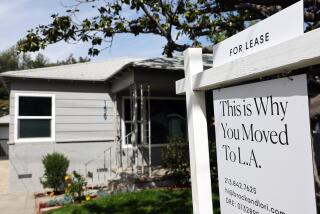Californiaâs Housing Crisis Affects Us All
Californiaâs working families canât pay the rent. Nowhere in the country can a minimum-wage worker afford a decent apartment, but in California, with the widest gap in the country between incomes and rent, even two minimum-wage earners canât find decent housing on their combined salaries.
Thatâs the key finding of a study released last week by the National Low Income Housing Coalition. Two trends--the widening income gap and the lack of housing production--account for this crisis situation. In Los Angeles, the average rent on a two-bedroom, nonluxury unit is almost $900 a month--up almost 10% from just a year ago. To afford this rent (without paying more than 30% of their income for housing), a family needs to make more than $17 an hour before taxes. But the stateâs minimum wage is only $5.75 an hour, about $12,000 a year. Put another way, a minimum-wage worker in Los Angeles must put in 120 hours a week to earn enough to have affordable housing. A mother and father would both have to work full-time, seven days a week for 52 weeks a year to pay the rent.
In Orange County, the âhousing wageâ is more than $19 an hour; in San Diego, itâs $16 an hour; and in San Francisco, it is $39. Working families that move inland (and commute longer hours) to find less-expensive housing will be in for a shock. In once-affordable Riverside County, the housing wage is now $13.33. In San Bernardino County, it is $13.94.
As a result, low-wage workers pay more than half their household incomes in rent and still live in slum buildings. In Los Angeles, for example, at least 150,000 apartments--one in nine--is substandard, according to a report by the Citizens Task Force on Slum Housing. More and more families now double-up in overcrowded apartments. Many families have to choose between paying the rent and paying for food, medical care and child care.
Cardinal Roger Mahony said recently that decent affordable housing is a prerequisite for the âprotection of human dignity.â
The housing crisis is not only a human tragedy. It is also a serious problem for businesses. Families that pay too much just to keep a roof over their heads have less disposable income to spend on other goods and services. The housing shortage also makes it difficult for businesses to attract and retain an adequate work force.
Low wages and high rents are a deadly combination. It makes it difficult, if not impossible, for many families to save enough money for a down payment on a home. No wonder only 39% of Los Angeles households own their own homes, compared with a national homeownership rate of 67%.
This situation shows that a ârising tideâ doesnât lift all boats; in fact, it increases rents and home prices. Our booming economy is creating large numbers of low-wage jobs, but not producing housing for these workers to live in. About 750,000 workers in Southern California alone earn the minimum wage, and millions of others earn only slightly more. But last year, Los Angeles County added only 6,525 new apartments, while the population grew by 169,000. Not surprisingly, vacancy rates are at an all-time low, putting more upward pressure on rents.
The solutions are obvious. We need to raise the incomes of working families and expand construction of affordable housing.
We can address the first problem by raising the minimum wage. The stateâs Industrial Welfare Commission currently is holding hearings across the state to consider a proposal to increase the minimum hourly wage by $1 within two years. This is far below whatâs needed to afford basic housing, but is a step in the right direction. Gov. Gray Davis should support this proposal.
We should expand participation in the federal earned income tax credit, which supplements the incomes of low-wage employees. Many eligible workers donât even know about it. We also should follow other states that have created their own earned income tax credit. And we can support efforts by workers to unionize so they can negotiate with employers for better wages and working conditions.
We can deal with the second problem by getting Congress to increase federal housing subsidies, such as the Section 8 voucher and housing block grant programs, and encouraging the state government to increase housing appropriations. At the municipal level, Los Angeles can learn from other large cities that contribute local revenues into housing trust funds to provide subsidies to consumers and developers.
Community groups, unions, business organizations and others should ask candidates for mayor and city councils what they intend to do to address our worsening housing problems.
The housing crisis threatens the well-being of millions of California families, the social fabric of our communities and the prosperity of our economy. We know how to close the gap between incomes and housing costs. But can we mobilize the political will to do so?
More to Read
Sign up for Essential California
The most important California stories and recommendations in your inbox every morning.
You may occasionally receive promotional content from the Los Angeles Times.






